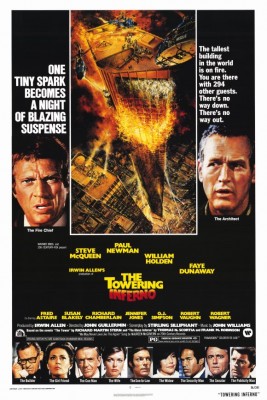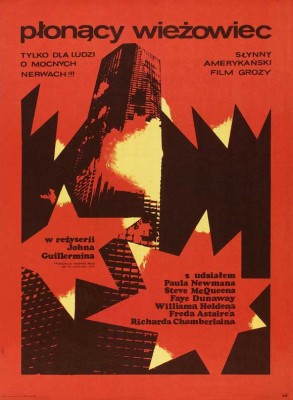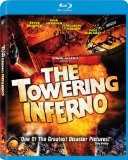| Reviews & Columns |
|
Reviews DVD TV on DVD Blu-ray 4K UHD International DVDs In Theaters Reviews by Studio Video Games Features Collector Series DVDs Easter Egg Database Interviews DVD Talk Radio Feature Articles Columns Anime Talk DVD Savant Horror DVDs The M.O.D. Squad Art House HD Talk Silent DVD
|
DVD Talk Forum |
|
|
| Resources |
|
DVD Price Search Customer Service #'s RCE Info Links |
|
Columns
|
|
|
Towering Inferno, The
But it's also cold-blooded and calculating. It may be the first truly sadistic mainstream Hollywood feature, and if not exactly the first, was certainly one of the landmark high-concept movies, less a movie really than a shrewdly packaged product, ingeniously fashioned into a must-see event appealing to a broad spectrum of film fans.
Fox's Blu-ray of The Towering Inferno offers a handsome presentation of the film that's a definite upgrade from the standard-def DVD, though its alternately grainy and soft-focus Panavision lensing will disappoint some. The disc is positively crammed with animated menus and extra features - hours and hours worth - but it also taxes older Blu-ray players, and all of it repeats material that originally appeared in the May 2006 Special Edition DVD. On my older model the disc took a good five minutes to load, was finicky about playing some of the supplements, and it was even difficult getting the disc to both stop and eject when I was done with it.
The unusual production borrows characters and plot elements from two different but similar novels: The Tower, by Richard Martin Stern, and The Glass Inferno, by Thomas N. Scortia and Frank M. Robinson, both of which reflected concerns over the safety of buildings like the then-new World Trade Center in New York and the in-construction Sears Tower in Chicago. Irwin Allen and Fox snapped up the rights to the former novel, and when they learned Warner Bros. had acquired rights to the latter the two studios joined forces, with Fox basically holding domestic rights and Warner Bros. the foreign distribution. I've also heard there was another reason: After the various studios made numerous expensive flops in the late-1960s and into the early-'70s, all agreed to keep production costs down across the board, and that the only way the $14 million Towering Inferno could be made without violating the industry-wide agreement was to co-produce the picture.
In any case, the story chronicles the disastrous opening of the Glass Tower in San Francisco, the tallest building in the world, designed by architect Doug Roberts (Paul Newman) and built by millionaire developer Paul Duncan (William Holden). (Amusingly though probably coincidentally, the Tower is across the street from The Fireman's Fund Insurance Company.) After some clumsy character development involving Doug's relationship with ambitious girlfriend Susan (Faye Dunaway), and scenes introducing septuagenarian shyster Harlee (Fred Astaire, fishing for a late-career Oscar, a la Helen Hayes in Airport) and his latest target, elegant senior Lisolette (Jennifer Jones), power surges and small fires begin breaking out all over the building*, just ahead of a glamorous dedication party on the 138-floor's Promenade Room, with Senator Gary Parker (Robert Vaughn) and Mayor Robert Ramsey (Jack Collins) among the 300 VIPs.
A distressed Doug learns that Duncan's devious son-in-law, Roger Simmons (Richard Chamberlain), altered the electrical specifications to save the company millions in construction costs, reducing Doug's super-cautious specs to minimum Building Code requirements. The fire spreads quickly but Duncan, believing his building fundamentally safe, is reluctant to move the politically important party downstairs to less luxurious surroundings - and pretty soon the fire cuts off their only means of escape. Meanwhile, Battalion Fire Chief Michael O'Hallorhan (Steve McQueen) arrives and together with a humbled, disgraced Doug tries to extinguish the fire and rescue those still trapped in the building.
Where Irwin Allen's previous hit, The Poseidon Adventure (1972), coupled an original and very clever premise - a tidal wave capsizes a huge ocean liner and survivors must work their way through the upside-down vessel to the surface - with characters the audience genuinely cared about, The Towering Inferno is instead a Grand Guignol spectacle of gruesome, fiery deaths. The film's camp value in recent years has been tempered somewhat by the 9/11 tragedy - it's hard not to watch this now and not be reminded of 9/11: characters falling or jumping to their deaths, the growing undercurrent of panic among those trapped, firemen struggling with equipment and the long climb to the top floors, and McQueen's line near the end, "You know, one of these days, you're gonna kill ten thousand in one of these firetraps," is eerily prophetic. (And in The Tower, set in New York, a terrorist's bomb starts the blaze, and a breeches buoy leading out of the burning building to safety - a plot element that turns up here as well - is connected to the World Trade Center.)
Two characters, executive Dan Bigelow (Robert Wagner) and a secretary he's sleeping with (Susan Flannery) - the film never mentions or implies whether Dan's married or not - are introduced solely to burn spectacularly like overcooked marshmallows over a campfire: he becomes a human torch while she flies alight through a glass window, falling to earth like a burning meteor. Late in the picture the script turns downright nasty, pointlessly killing off one likeable character to provide a cheap - but crudely effective - shock that still jolts audiences from their seats, even today.
The screenplay is clunky in strange ways. Newman's character, by default the lead among leads, is basically a First Class Schmuck. He naively assumed Simmons and others wouldn't find ways to cut corners during the pricey building's construction, then when fires do start breaking out he ineffectually tries to shut everything down and evacuate the building. McQueen's fire chief reads him the riot act and though he saves a few people along the way, Newman's character spends the rest of the film taking orders from his co-star.
McQueen doesn't even appear until more than 43 minutes in, but then completely dominates every frame he's in. Unlike Newman's character, there's no lame backstory to his character, and in one sense no character at all. Just like the ingenious posters, pigeonholing the stars into archetypal character types, McQueen is nothing more or less than "The Fireman." Absolutely everything he does in the movie is fireman work, and McQueen's all-business performance is mesmerizing. He's experienced, exhausted, cynical, dispirited, determined, and though star power bursts from out of his prematurely aged face like the starlight bursting through Universal Studios' art deco logo of the 1940s, at the same time he's completely believable and authentic. So much so, in fact, one wishes he had played the character in a better movie. In one scene, after a particularly harrowing rescue, McQueen's fireman pauses just long enough to exchange glances of relief and shared survival with another firefighter. The look on McQueen's face is priceless, and all by itself justified the actor's then-huge $1,500,000 + 10% of the gross salary. **
Others in the cast have varying degrees of star power, but come off little better than workmanlike. Holden and Dunaway were better in other films (1976's Network for one), though Dunaway's see-through dress is an eyeful. (Watch Holden sneak a peek at Dunaway's very visible boob in one shot!) Allen cast his wife, Shelia, as the luckless mayor's wife, though the nepotism isn't as bad here as it would be in When Time Ran Out... (1980), in which Mrs. Allen's character is whisked across a rickety bridge over a river of lava by a clearly embarrassed Paul Newman.
The film has High Concept written all over it: the multi-generational cross section of movie and TV stars, recording stars and athletes. Looking for the same hit song/tie-in enjoyed by The Poseidon Adventure's "(There's Got to Be) A Morning After," that tune's singer, Maureen McGovern, has been brought back for another hit, "We May Never Love Like This Again," though her character has the good sense to skedaddle before the fire starts. O.J. Simpson, as a wholesome security guy, gets to save a kitten. No comment.
This was a big movie that embraces its bigness. The film opens with Cinerama travelogue-like aerial shots approaching San Francisco, to John Williams's memorable score (though it's not as memorable as the one he wrote for The Poseidon Adventure, a somewhat underrated work). Producer Allen had no peer when it came to tacky bad taste, however, particularly when it came to costume and set design. The Towering Inferno is less extreme than his later, comically bad epics, but the enormous Promenade Room set (quite impressive size-wise on big TVs) is singularly ugly, even by mid-1970s standards: with its sickly green carpeting and white and gold wrought iron motifs it looks like the Grand Ballroom at a resort dedicated to miniature golf.
Still, it's an undeniably impressive production, with excellent matte and miniature effects - a "helicopter" shot looking down over the burning building near the end of the film is especially good. The stunt work is excellent and, though overlong, the picture has enough action in it for three movies. If only it weren't so nasty.
Video & Audio
Filmed in Panavision by Fred J. Koenekamp and Joseph F. Biroc, The Towering Inferno gets a boost from its standard-def DVD version, but the title elements are soft and muddy, and throughout the film one notices a softness around the edges of the frame, accentuated by the anamorphic lenses. Still, one can read much more in the faces of the actors (and the prematurely aged ones like McQueen and Holden look even older), while the miniature and matte painting shots look fantastic in high-def and, for the most part, still hold up. The 1080p transfer is on a 50GB disc so crammed with extras that on older players it seems like an eternity to load. Menu screens cleverly place the viewer aboard the doomed scenic elevator looking over the San Francisco skyline.
There are three English audio tracks, in 5.1 DTS-HD Master Audio, a 4.0 surround mix, and a Dolby Surround one. The music and sound effects benefit most, though there is some nice directionality to the dialog here and there. A Spanish mono track is also included, along with English SDH, Spanish, and French subtitles.
Extra Features
Supplements, plentiful though they may be, are all from the 2006 Special Edition DVD :
Audio Commentary by F.X. Feeney
Scene Specific Commentary by Mike Vezina, Special Effects Director on X3
Scene Specific Commentary by Branko Racki, Stunt Coordinator on The Day After Tomorrow
32 Extended and Deleted Scenes [all full frame and edited for content] and 1 Alternate Opening Sequence
An exhaustive making-of documentary, for union/guild reasons broken up into myriad mini-featurettes:
Inside the Tower: We Remember
Innovating Tower: The SPFX of an Inferno
The Art of Towering
Irwin Allen: The Great Producer
Directing the Inferno
Putting out Fire
Running on Fire
Still the Worlds Tallest Building
The Writer: Stirling Silliphant
Also included is AMC Backstory: The Towering Inferno, Six Storyboard Comparisons, a NATO [National Association of Theater Owners] Presentation Reel, two 1974 featurettes, an interview with Irwin Allen, from 1977, and trailers. Finally, Interactive Galleries, include American Cinematographer articles, and Stills Galleries.
Parting Thoughts
Shameless and tacky but also slick and exciting, The Towering Inferno is cold-blooded entertainment at the dawn of a new age for big budget Hollywood movies. Though in many respects a gaudy, unpleasant film, there's also much to recommend it, and should be seen at least once. The Blu-ray is an upgrade from the standard-def DVD, but those who already own the Special Edition DVD may be satisfied with that. For others, this is, ultimately, Highly Recommended.
* The over-emphatic set decorator stuffs the storage room where a spark-happy circuit breaker sets off the Big Blaze with a huge pile of oily rags, shelves loaded with cans of spray paint, paint thinner, etc. It's comically overdone, like something you'd see on The Simpsons.
** McQueen also has the best line in the film, a line regrettably cut from TV airings: "Aw, shit!"
Film historian Stuart Galbraith IV's latest book, Japanese Cinema, is on sale now.
|
| Popular Reviews |
| Sponsored Links |
|
|
| Sponsored Links |
|
|
| Release List | Reviews | Shop | Newsletter | Forum | DVD Giveaways | Blu-Ray | Advertise |
|
Copyright 2024 DVDTalk.com All Rights Reserved. Legal Info, Privacy Policy, Terms of Use,
Manage Preferences,
Your Privacy Choices | |||||||















